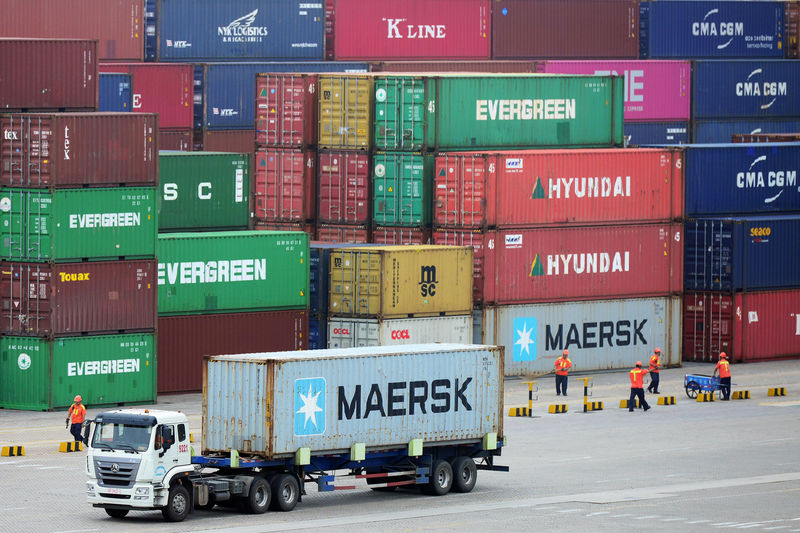By Yawen Chen and Gabriel Crossley
BEIJING (Reuters) - A slide in China's exports picked up pace in September while imports contracted for a fifth straight month, pointing to further weakness in the economy and underlining the need for more stimulus as the Sino-U.S. trade war drags on.
Analysts say it could take time for Chinese exports to recover given slowing global growth, despite tentative signs of a thaw in tense trade relations between the world's top two economies.
On Friday, U.S. President Donald Trump outlined the first phase of a deal to end the trade war with China and suspended a threatened tariff hike set for Oct. 15. But existing tariffs remain in place and officials on both sides said much more work needed to be done.
September exports fell 3.2% from a year earlier, the biggest fall since February, customs data showed on Monday. Analysts in a Reuters poll had expected a 3% decline after August's 1% drop.
"The headline figures suggest that global demand softened last month, adding to the pressure from the U.S. tariffs that went into effect in September," said analysts at Capital Economics.
Economists also attributed the export slowdown to a fading in the so-called "front-loading" effect. Some Chinese firms had rushed to ship goods to the United States ahead of the September deadline, supporting overall July and August export readings.
"We expect shrinking exports will likely be one of the biggest drag on China's economic growth in the coming months, as the tariff impact will be further in place, along with the pay-back effects," said Ting Lu, chief China economist at Nomura.
Total September imports fell 8.5% after August's 5.6% decline, the lowest since May, and were expected to fall 5.2%.
Some sectors held a silver lining. China's industrial metals imports, including iron ore and copper, surged in September fueled by firm demand at steel mills.
But analysts at ANZ noted volumes were buoyed by recovery from recent disruptions in Australia and Brazil, and may also have been lifted by restocking ahead of China's 70th anniversary celebrations, suggesting overall demand remains weak.
Nomura's Lu pointed to subdued imports in the raw material processing sector and softening global commodity prices possibly playing a role in depressing overall imports.
Despite more than a year of growth boosting measures, China's domestic demand has remained stubbornly weak as economic uncertainty weighs on business and consumer confidence and discourages fresh investment.
Downward pressure on China's economy is increasing and the government will make good use of counter-cyclical adjustments to keep economic growth within a reasonable range, state television quoted premier Li Keqiang as saying.
TRADE SURPLUS
China reported a trade surplus of $39.65 billion last month, compared with a $34.84 billion surplus in August. Analysts had forecast $33.3 billion.
Its trade surplus with the United States stood at $25.88 billion in September, narrowing from August's $26.96 billion.
China's exports to the United States fell 10.7% from a year earlier in dollar terms in January-September, while U.S. imports dropped 26.4% during that period, the customs data showed.
September had marked a major escalation in the trade row, with Washington imposing 15% tariffs on more than $125 billion in Chinese imports from Sept. 1, and Beijing hitting back with retaliatory levies.
Though President Trump had agreed not to proceed with a hike in tariffs set for Tuesday, U.S. Trade Representative Robert Lighthizer said Trump had not made a decision about tariffs that were subject to go into effect in December.
Analysts are also skeptical that the "mini deal" would mark a major breakthrough.
"It is difficult to take that much comfort from the latest signs of progress given that we've had plenty of apparent truces in recent months end abruptly in a sudden further escalation in trade tensions," said analysts at Capital Economics.
Customs spokesman Li Kuiwen told a news conference on Monday China's stable domestic economy had provided a strong cushion against external challenges, but added that trade development in the future was still complicated and severe.
Economists at UBS expect further pressure on China's job market as the impact of the latest U.S. tariff escalations filter through to struggling manufacturers.
"We think the time to watch for potentially significant job losses is from December this year until March 2020, assuming all announced tariff hikes are implemented. Job losses may be more concentrated in a few sectors that have higher exposure to foreign final demand, such as textiles, computers and electronics and electrical equipment, among others."
Analysts believe China's economic growth cooled further in the third quarter from a near 30-year low of 6.2% hit in April-June, and is threatening to breach the lower end of the government's full-year target of 6.0-6.5%.
A growing number of economists are forecasting growth could fall into the upper 5% range in 2020 due to lingering trade tensions and a combination of cyclical and structural factors.
